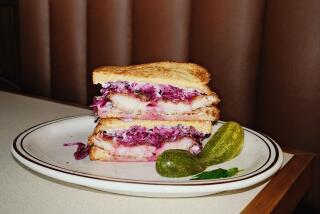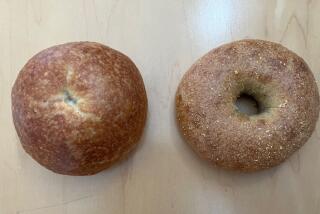Recipe: Bagels

- Share via
Total time: 1 hour, 15 minutes plus chilling, rising and cooling time for the dough and bagels
Servings: 6 to 8 bagels
Note: Barley malt, also known as barley malt syrup, is generally available at health food stores including Erewhon Natural Foods in Los Angeles and Granny’s Pantry in Pasadena, as well as at most Whole Foods Market stores. Instant yeast is generally available at cooking and baking supply stores. Despite the short work time, this recipe takes two days to make because of the rising time. If you make more than 6 bagels, you may need to prepare 2 baking sheets. Toppings can include poppy or sesame seeds, coarse salt, dehydrated onion or garlic bits that have been soaked, and cinnamon sugar.
3 1/2 cups (1 pound) unbleached bread flour
3 teaspoons salt, divided
3/4 teaspoon instant yeast
1 tablespoon barley malt syrup (or honey)
1 cup plus 2 tablespoons water
1 teaspoon baking soda
Toppings as desired
1. In the bowl of an electric mixer or food processor or by hand, mix the flour, 2 teaspoons salt, the yeast, barley malt syrup and 1 cup plus 2 tablespoons water until the ingredients form a stiff, coarse ball of dough (about 3 minutes if mixing by hand or in a mixer; or 1 minute in a food processor). If necessary, add a little more water. Let the dough rest 5 minutes.
2. Knead the dough on a lightly floured surface until the dough feels stiff yet supple, with a satiny, slightly tacky feel, 2 to 3 minutes. If the dough seems too soft or too tacky, sprinkle over just enough flour as needed.
3. Place the dough in a lightly oiled bowl, cover tightly with plastic wrap, and place it in the refrigerator for at least 1 hour and up to several hours. Keep in mind that the bagels must be shaped before proofing overnight.
4. When ready to shape the bagels, line a baking sheet with lightly greased parchment paper or a silicone baking mat.
5. Remove the dough from the refrigerator and divide it into 6 to 8 equal pieces. Form each piece into a loose, round ball by rolling it on a clean, dry work surface with a cupped hand; do not use any flour on the surface. If the dough slides around and won’t ball up, wipe the work surface with a damp paper towel and try again -- the slight amount of moisture will provide enough “bite” for the dough to form a ball. When each piece has been formed into a ball, you are ready to shape the bagels.
6. Using your hands and a fair amount of pressure, roll each dough ball into a “rope” 8 to 10 inches long. (Moisten the work surface with a damp paper towel, if necessary, to get the necessary bite or friction). Slightly taper the rope at the ends so that they are thinner than the middle. Place one end of the dough between your thumb and forefinger and wrap it around your hand until the ends overlap in your palm; they should overlap by about 2 inches. Squeeze the overlapping ends together and then press the joined ends into the work surface, rolling them back and forth a few times until they are completely sealed.
7. Remove the dough from your hand and squeeze as necessary to even out the thickness so that there is a 2-inch hole in the center. Place the bagel on the prepared sheet pan. Repeat with the other pieces. Lightly wipe the bagels with oil, cover with plastic wrap and place in the refrigerator overnight.
8. Remove the bagels from the refrigerator 90 minutes before you plan to bake them. Fill a large stockpot with 3 quarts of water (be sure the water is at least 4 inches deep), cover with a lid, and slowly bring the water to a boil. When it comes to a boil, add the remaining teaspoon of salt and 1 teaspoon of baking soda, reduce the heat and simmer with the lid on.
9. Thirty minutes before baking, heat the oven to 500 degrees.
10. Test the bagels by placing one in a bowl of cold water. If it sinks and doesn’t float to the surface, return it to the sheet, wait 15 minutes and then test it again. When one bagel passes the float test, they are ready for the pot.
11. Gently lift each bagel and drop it into the simmering water. Add as many as will comfortably fit in the pot. After 1 minute, use a slotted spoon to flip each bagel over. Poach for an extra 30 seconds. Using the slotted spoon, remove each bagel and return it to the lined baking sheet. Continue until all the bagels have been poached. Generously sprinkle each bagel with a topping, except for cinnamon sugar (see note below).
12. Place the baking sheet in the oven and reduce the heat to 450 degrees. Bake for 8 minutes and then rotate the sheet (if using two sheets, also switch their positions). Check the underside of the bagels. If they are getting too dark, place another sheet under the baking sheet (i.e., double-pan it). Bake until the bagels are golden brown, an additional 8 to 12 minutes. Remove from the oven and transfer the bagels to a rack for at least 30 minutes before serving.
Note: If using cinnamon sugar (1 part cinnamon to 5 parts granulated sugar), immediately brush the top of each hot bagel with melted butter and then generously sprinkle with the mixture so that it is coated. It will form a nice cinnamon crust as it cools.
Each of 8 servings: 226 calories; 7 grams protein; 46 grams carbohydrates; 2 grams fiber; 1 gram fat; 0 saturated fat; 0 cholesterol; 1,031 mg. sodium.
More to Read
Sign up for The Wild
We’ll help you find the best places to hike, bike and run, as well as the perfect silent spots for meditation and yoga.
You may occasionally receive promotional content from the Los Angeles Times.










